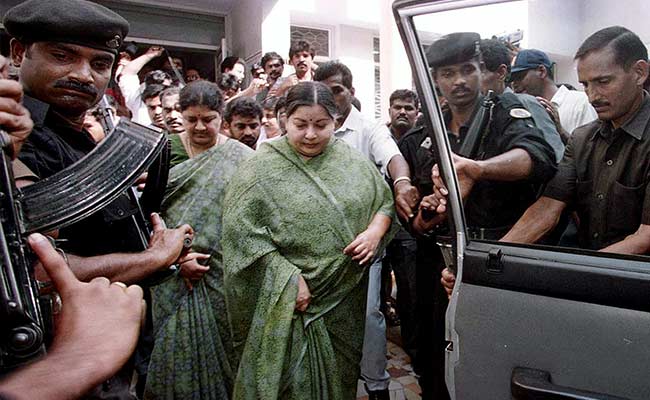
NEW DELHI: Even as Jayalalithaa today challenged her conviction in a 1996 case of corruption, prosecutors claim that the paper trail of money provides clinching evidence that the former Tamil Nadu Chief Minister used unaccounted for cash to buy land worth huge amounts of money.
Convinced by that reasoning, a Bangalore court has sentenced Jayalalithaa, 66, to four years in jail and penalised her with a 100-crore fine.
The prosecution says that Jayalalithaa and her three aides including Sasikala Natarajan who lives with her used front companies to amass 3,000 acres of land assets worth 66 crores. The properties were bought between 1990-1996, Jaylaalithaa’s first tenure as Chief Minster, when her declared income added upto just two crores.
Most of the land was bought by six companies – Lex Property Development Pvt Ltd, Ramraj Agro Mills, Meadow Agro Farms, Riverway Agro Products, Indo-Doha Chemicals & Pharma and Signora Business Enterprises – largely defunct at the time, in which Sasikala and her relatives were directors.
Jayalalithaa’s lawyers took two lines of argument, both of which fell through.
Initially, they argued that she had nothing do with the companies since she was neither director nor shareholder in any of them. But prosecutors produced direct evidence of money into these firms from two companies in which Jayalalithaa was a director along with Sasikala – Jaya Publications and Sasi Enterprises. Several cheques had been signed by Jayalalithaa herself.
Later in the trial, to account for the politician’s increasing assets, lawyers claimed that Jaya Enterprises, which published a mouthpiece newspaper for her party, the AIADMK, raised Rs. 14 crores through a subscription scheme. Fans, they said, deposited amounts ranging from Rs. 12, 000-Rs. 18,000 in exchange for a lifetime subscription to the newspaper.
The prosecution however proved in court that a large number of these subscribers appeared to lack credibility.
In a damning slip-up, when the defense produced 1000s of deposit slips before the court in 2013, the prosecution showed that in 2001, Jaya Enterprises had officially informed tax officials that all deposit slips had been lost, and a police complaint lodged about the missing records.
The defence also claimed that another company owned by Sasikala, Super Duper TV, had raised six crores through the sale of satellite dishes as part of a scheme where customers had to deposit Rs. 5000 each. Once again the prosecution claims they could prove that these depositors were bogus.
One of the other unexplained expenses was the estimated six crores that the prosecution claimed Jayalalithaa spent on the extravagant wedding of her foster-son Sudhakaran in 1996. Jayalalithaa’s lawyers initially argued that she didn’t spend a penny, and that the entire expenses were borne by the bride’s family. But later, when the prosecution produced proof of cheque payments made by Jayalalithaa to wedding suppliers, she accepted that she had spent 26 lakhs on the event.
If the 66 crores that Jayalalithaa accumulated was not from genuine business activity, where was it coming from?
The prosecution found that all the payments into Jayalalithaa’s and Sasikala’s accounts were made in cash, sometimes running into lakhs of rupees by just two individuals – Jayaraman and Rama Vijayan – which the prosecution claims were both employees of Jayalalithaa at her Poes Garden residence.
This, they successfully argued, suggested ill-gotten wealth making its way directly from the politician’s residence into her bank accounts.
Since the filing of the chargesheet, all these land assets have been seized. The court has ordered that they be sold to raise the Rs. 100 crores penalty imposed on Jayalalithaa.


